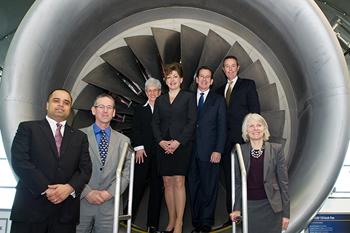University of Connecticut Receives $1.5 Billion for STEM Education
 STORRS, Conn. — Science, Technology, Engineering and Mathematics (STEM) disciplines at the University of Connecticut are set to undergo a massive transformation after Governor Dannel Malloy gave final legislative approval for a $1.5 billion investment in the university.
STORRS, Conn. — Science, Technology, Engineering and Mathematics (STEM) disciplines at the University of Connecticut are set to undergo a massive transformation after Governor Dannel Malloy gave final legislative approval for a $1.5 billion investment in the university.
Dubbed “Next Generation Connecticut,” the expansion will include the renovation of aging buildings, the relocation of the Greater Hartford Campus to downtown Hartford, the construction of new STEM teaching laboratories and building additional STEM facilities for materials science, physics, biology, engineering, cognitive science, genomics and more. The colossal construction proposal is expected to bring about 30,000 construction jobs.
“We believe that Next Generation Connecticut represents one of the most ambitious state investments in higher education, economic development, and research in the nation,” said Sally Reis, vice provost for academic affairs. “Next Generation Connecticut will enable us to target strategic investments in facilities, faculty, and recruit and educate students who will establish UConn as a vital STEM university, invigorating Connecticut’s economy with new technologies, highly skilled graduates, new companies, patents, licenses, and high-wage STEM jobs.”
The state’s last large scale investment in the university was the UConn 2000 and 21st century initiatives, implemented in 1995. Numerous STEM buildings were constructed as part of this initiative as well as buildings not based in the sciences. The initiative continues today with the construction of the engineering and psychology buildings now underway and the renovation of the agricultural research facilities.
From these recent constructions and renovations, the university saw a 122 percent increase in research awards and an increase of 115 percent in undergraduate enrollment of STEM programs.
The university believes that further investments in STEM education will reap even larger rewards for the university and for the Connecticut’s economy. According to the Bureau of Labor Statistics, STEM jobs grew three times faster than non-STEM jobs from 2000 to 2010 and approximately two-thirds of GDP growth was attributed to STEM innovations. The university also received $900 million in STEM research proposals last year.
“We believe that Next Generation Connecticut will invigorate Connecticut’s long-term economic competitiveness and result in job creation, economic growth, increased numbers of patents and inventions, many of which will enhance our ability to innovate and invent, thus benefiting both the state and the nation,” Reis said.
By 2024, the university expects Next Generation Connecticut to garner $146 million in new research awards annually, $285 million in new business activity in Connecticut annually, 2,190 new or 4,050 permanent jobs.
The current facilities allowed by UConn 2000 initiatives are already at capacity due to the rapid growth of the STEM student population. Thanks to the new initiative, the university will enroll 6,580 additional students and hire 259 new faculty members and create a STEM honors program.
“We will create one of, if not the most comprehensive STEM honors programs in the country, with new STEM honors housing and mentorships of STEM doctoral fellows to work with talented undergraduate students,” Reis said.
According to Gov. Malloy, the transformation will bring the school and the state into a new era on innovation.
“Connecticut used to lead the world when it came to innovation — we had more patents, more groundbreaking discoveries than anywhere else in the world. Somewhere along the way the world caught up. This is about to change,” Malloy said in a statement. “By targeting state resources to our flagship university we ensure that our young people have the skills they need to fill the jobs we are so aggressively pursuing. Make no mistake, we are making Connecticut competitive again.”
